
|

|
|
Home Site Search Contact Us Subscribe
|
|
|
Loud on the Outside, Quiet on the Inside: Experimental Media and Performing Arts Center (EMPAC) by Grimshaw and Davis Brody Bond Aedas Troy, NY: How do you "ground" a 221,200-square-foot building on a 30-degree slope? And how do you acoustically carve out grand venues that are designed for digital technology and electronic performance? Structural and MEP engineer Buro Happold explains. By Craig M. Schwitter, P.E. February 5, 2009 The Experimental Media and Performing Arts Center (EMPAC) was nearly a decade in the making. In 1999, as part of a strategic plan for Rensselaer Polytechnic Institute (RPI), the university earmarked a “transformational” project for its campus in Troy, New York. A year later, RPI obtained a gift from an anonymous donor to build an electronic media and performing arts center.
As the nation’s oldest technological university with one of the first undergraduate programs in electronic media and arts in the United States, RPI wanted to validate its position at the forefront of the field. Following a design competition, Grimshaw was selected as design architect, working in association with architect-of-record Davis Brody Bond Aedas.
Built into a sloping site on the edge of the campus overlooking the Hudson River and Albany, EMPAC was intended to serve as a bridge between the natural world and digital world. In the words of RPI President Shirley Ann Jackson, “building into bedrock was symbolic of building into the future.”
EMPAC had no precedent. It consists of two parallel structures that separate the traditional and experimental venues. The north wing has a large atrium surrounding a 1,200-seat concert hall, the centerpiece of the complex. The south wing contains a 400-seat theater, two performance studios, a rehearsal studio, and four artist-in-residence studios. There were many challenges: difficult site conditions, a changing and evolving building program, acoustical and seismic isolation requirements, and the incorporation of state-of-the-art technology. Working closely together with the client and the entire building team, Buro Happold helped to resolve the complexities inherent in the project.
Five Miles of Anchors Below the Surface
Although EMPAC’s structural system is mostly concealed, this large project is firmly anchored into the ground. Because the site contains sand, gravel, and expansive clays, the building’s foundations were extremely difficult to design. In addition, the building had to conform to the International Building Code, adopted by New York State in 2002. The geotechnical classification was Site Class D, which placed the building in Seismic Design Category C.
Geotechnical engineers who conducted detailed tests on the soil conditions determined that the clays could become subject to instability if they were disturbed. They also studied the seismic effect of soil loads in conjunction with peer review by RPI faculty.
To support the large horizontal forces of the building and literally hold back the hillside, more than 200 permanent rock anchors were drilled into the bedrock. The anchors are: · As long as 180 feet each, and total nearly five miles in length · Single and multiple high strength bar arrangements with double corrosion protection systems · Resistant to horizontal soil loads
The primary vertical foundations are caissons drilled into bedrock. The caissons measure 3.5 feet in diameter and are located primarily on the lower section of the site where the vertical loads are highest. Minipiles were used for the upper foundations because they could be accurately placed between the anchors.
Façades That Bring A Warm and Fuzzy Feeling
One of the most striking features of EMPAC is the glazed wall of the north wing. The wall is only 35 feet tall at the top of the hill, yet it is 100 feet high at the base of the slope. Peeking through this highly transparent surface from the inside of the building, the concert hall looks like an object in a display case. The absence of cross bracing and the use of minimal supporting steel heighten the façade’s transparency. It consists of double-insulated, low-iron panels, each measuring 12 feet by 6 feet.
In addition, curtainwall consultant Josef Gartner created a radiant façade system. Originally developed in the United States to protect steel structures from fires, these types of systems have been utilized extensively in Europe to heat buildings. Used here as a heating system for the first time in the U.S., it consists of heated mullions that circulate a water-glycol solution. Computational fluid dynamics helped to predict the heating requirements of the interior spaces and prevent condensation.
Raising the Roof
The concert hall is the centerpiece of the north wing. More than just a functional element, it supports the complex’s roof and skylight arrangement.
The concert hall has a traditional shoebox structure, made of concrete, with 12-inch walls that provide lateral resistance. Their slight convex curve perfects acoustic performance. On the inside of the hall, cast stone panels are suspended from the walls, which thickens them by as much as 12 inches more. ETABS software was used to conduct a modal review for seismic purposes.
The attic and roof slab provide overall rigidity to the structure. Concrete columns frame the concert hall walls and strengthen the roof and floor planes. The roof has steel trusses that span its 80-foot width. Their bottom chords are integrated with a 14-inch composite attic slab that forms an acoustic barrier, as well as a large space to mount performance equipment. The curved top chords underpin the shape of the north wing’s double-curved roof, and have an eight-inch cast slab on metal decking.
The curved shape around the concert hall is created by an outer steel framework, or hull, clad in cedar planks. The hull provides additional circulation space around the hall and braces parts of the concrete walls. Primary features of the hull are: · Its surface, which is composed of double-curved, cold-formed steel stud wall panels that hold the cedar cladding · Full integration, enabled by three-dimensional software, of the steelwork, cladding and the mechanical ducts which run through the circulation space · Circular portholes, cut into the hull, for access bridges from the atrium
At the west end of the building, the roof is structurally divided into two parts. The portion above the atrium is constructed from pairs of 125-foot tied steel arches, which are positioned on columns with pin ends at the top and bottom. To stabilize the lateral system and resist wind and seismic loads, the roof is connected to the concrete box of the concert hall through a series of braced connections in the skylight and attic areas. This eliminated the need for cross bracing in the lobby or along the north façade to achieve a visually uncluttered space.
The atrium roof splits around the concert hall and forms two long north-south wings. Between the wings, a skylight follows the curving form of the concert hall. The skylight is constructed from customized tubular steel sections and inflated cushions of Ethylene tetrafluoroethylene (ETFE), a transparent and lightweight plastic. Bracing through the skylight allows the lobby roof diaphragm loads to pass through it.
Buildings That Float and Floors That Whisper
The south block consists of three independent venues: a 400- seat theater and fly tower, an audio studio, and a visual studio. It also contains a lobby, administration offices, artist-in-residence studios, and mechanical support spaces.
Each of these venues is a concrete box that is wrapped in a steel frame structure to maintain acoustic isolation. Sliding bearing connections between the steel frames also provide separation in the case of seismic events.
The following are aspects of the individual venue “box-in-box” structures: · The 400-seat theater is a concrete box physically separated from its surrounding steel frame. · Studio 1, the 3,500-square-foot visual studio, is supported on springs that “float” the structure over its foundations for premier acoustic performance; steel trusses span the top of the box. · Studio 2, the 2,500-square-foot audio studio, is supported on grade, due to its proximity to the rear retaining wall and anchors; its foundations are isolated to prevent noise transmission.
Conclusion EMPAC is a building with many unusual site conditions and a complex academic program with diverse functions. RPI had the vision to create an unprecedented center for world-class performance that supports state-of-the-art technology. At the same time, the design team had to resolve the challenges of building a top-notch performing arts facility with multiple, large venues on a sloping site. Working together closely, the team members developed a number of high-performance solutions that make building iconic, make it sound great, and – above all – make it stand.
Craig M. Schwitter, P.E. is a principal at Buro Happold. He served as partner-in-charge of structural engineering on the EMPAC project.
Client: Rensselaer Polytechnic Institute, Troy, NY Design Architect: Grimshaw, New York, NY Team: Vincent Chang, Sir Nicholas Grimshaw, Mark Husser, Andrew Whalley (Project Partners), Simon Beames, Shane Burger, David Burke, Demetrios Comodromos, Chris Crombie, Nikolas Dando-Haenisch, Chris Duisberg, Matt Eastwood, Paulo Faria, William Horgan, Kirsten Lees, Melissa Lim, Theo Lorenz, Junko Nakagawa, Michael Pawlyn, Juan Porral, Mariam Mojdehi, Barbara Kurdiovsky (Project Team) Architect-of-Record: Davis Brody Bond Aedas, New York, NY Team: J. Max Bond Jr., FAIA, William Paxson, AIA (Partners-in-Charge), Ernesto Bachiller, AIA (Project Manager), Bruce Dole, Jon Edelbaum, Dean Ficek, Steven J. Fischer, AIA, Robert Halverson, Fernando Hausch-Fenn, Nathan Hoyt, AIA, Fareh Garba, Richard Klibschon, Belinda Len, Ying Li, Marc Massay, Donald Nicoulin, Glenn O'Neill, Danny Papajic, Oliver Sippl, Mayine Yu, Dohhee Zhoung (Project Team)
Structural/Mechanical/Plumbing Engineer, Sustainability Consultant, Simulation Analysis Consultant: Buro Happold, New York, NY Team: Craig Schwitter (Partner-in-Charge of Structural Engineering), Denzil Gallagher (Partner-in-Charge of MEP Engineering) Electrical Engineer: Buro Happold and Laszlo Bodak Engineering LEED Consultant: Buro Happold and Turner Construction Company Acoustician: Kirkegaard Associates, Chicago, IL; Larry Kirkegaard, FASA, Hon. AIA (President and Principal Acoustician), Louie Sunga (Project Manager, Architectural Integration and Room Acoustics), Terry Tyson, P.E. (Mechanical Noise and Vibration Control), Tim Gulsrud, Zackery Belanger, Anthony Shou, Ben Willt (Project Team) Audio and Video Systems: Kirkegaard Associates; Richard Laidman, Jonathan Darling, Joanne Chang, Dennis Hoernig (Project Team) Theatre Consultant: Fisher Dachs Associates, New York, NY; Joshua Dachs (Principal), Peter Rosenbaum (Project Manager) Quantity Surveyor: Donnell Consultants Inc., Tampa, FL Construction Manager: Turner Construction Company Landscape Architect: The Saratoga Associates, Saratoga Springs, NY Civil Engineer: Clough, Harbour & Associates LLP Architectural Lighting: Office for Visual Interaction, New York, NY Fire Engineering: Arup Fire, New York, NY IT Consultant: Shen, Milsom & Wilke, New York, NY
|
(click on pictures to enlarge) 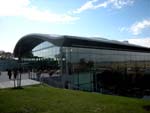 Kristen Richards Experimental Media and Performing Arts Center (EMPAC) at Rensselaer Polytechnic Institute; east entrance at the top of the hill 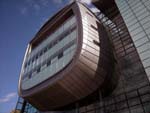 Kristen Richards West façade 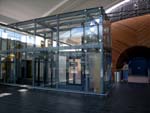 Kristen Richards Glass-enclosed elevators take on a sculptural presence in the concert hall lobby 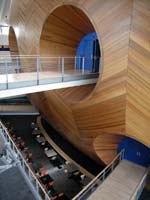 Kristen Richards Bridges across the atrium lead to the concert hall’s circular entrances 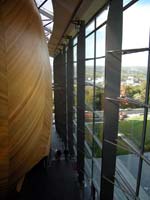 Kristen Richards A stairway between the rounded “hull” form of the concert hall and the north façade; midway down, doors lead to an outdoor terrace. The curtainwall includes a radiant façade system with heated mullions that circulate a water-glycol solution 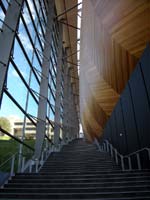 Kristen Richards View up the north stairway 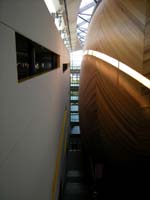 Kristen Richards The south-side stairway is flanked by the concert hall and the south block, housing the theater and studios 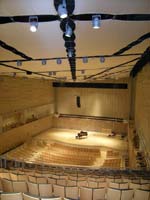 Kristen Richards The 1,200-seat concert hall 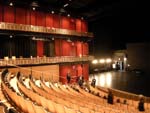 Kristen Richards The 400-seat theater sports a 70-foot fly tower with computer-controlled rigging 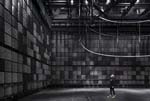 Peter Aaron/Esto Stduio 1 is a 3,500-square-foot visual studio supported on springs that “float” the structure over its foundations 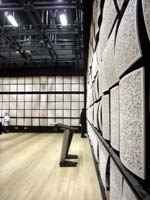 Kristen Richards Studio 2 is a 2,500-square-foot audio studio supported on grade with an isolated foundation to prevent noise transmission  Grimshaw/Davis Brody Bond Aedas North elevation  Grimshaw/Davis Brody Bond Aedas Performance hall section  Grimshaw/Davis Brody Bond Aedas South block section showing theater and studios  Buro Happold Section detail of anchors, some as long as 180 feet, installed at a 30-degree angle through clay and sand to bedrock 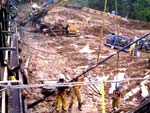 Buro Happold Weather and ground water resulted in very challenging conditions for the installation of the anchors |
© 2009 ArchNewsNow.com